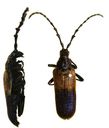Flower Longhorn Beetles
Lepturinae
Classification
- Phylum: Arthropoda
- Subphylum: Hexapoda
- Class: Insecta
- Order: Coleoptera
- Suborder: Polyphaga
- Superfamily: Chrysomeloidea
- Family: Cerambycidae
- Subfamily: Lepturinae
Pronunciation
How to pronounce Lepturinae: /lɛpˈtjuːˌraɪniː/
These audio files are automatically generated. While they are not always 100% accurate, they are a good starting point.
Images






Summary
Lepturinae, commonly known as flower longhorn beetles, is a subfamily within the longhorn beetle family, Cerambycidae. With around 200 species in the Northern Hemisphere and over 1500 species worldwide, they are notable for their slender bodies, their association with flowers, and their unique anatomical features.
Physical Characteristics
These beetles are usually among the smaller members of their family, displaying a slender shape with the thorax being markedly less wide than the wings. The tips of the elytra are often pointed. Antennae are not directly adjacent to the compound eyes, leading to oval-shaped eyes rather than those with indentations.
Identification Tips
Look for the terminal segment of the maxillary palps, which is typically blunt or truncate at the apex. The coxae are conical, and the bases of antennae are usually not surrounded by the eyes.
Habitat
Primarily found in flower-associated habitats, they can be found in forests, gardens, and meadows in the Northern Hemisphere.
Distribution
Lepturinae is most diverse in the Northern Hemisphere, with around 1500 species in over 200 genera worldwide.
Diet
Adults are known to feed on pollen and nectar of flowers, while larvae typically develop in decaying wood or other plant materials.
Life Cycle
The life cycle involves eggs being laid in decaying wood, where larvae develop into adults.
Reproduction
Details about the specific reproductive behaviors can vary among genera, but generally involve the laying of eggs in suitable substrates such as decaying wood.
Ecosystem Role
They play a role in pollination as adults feed on flowers, and the larvae contribute to the decomposition of plant material.
Evolution
Lepturinae has evolved distinct features that separate it from other groups within Cerambycidae, including unique eye and antenna arrangements. It was formerly considered closely linked with the subfamily Necydalinae, which is now classified separately.
Tags
- beetles
- Coleoptera
- Cerambycidae
- Lepturinae
- insects
- pollinators
- Northern Hemisphere